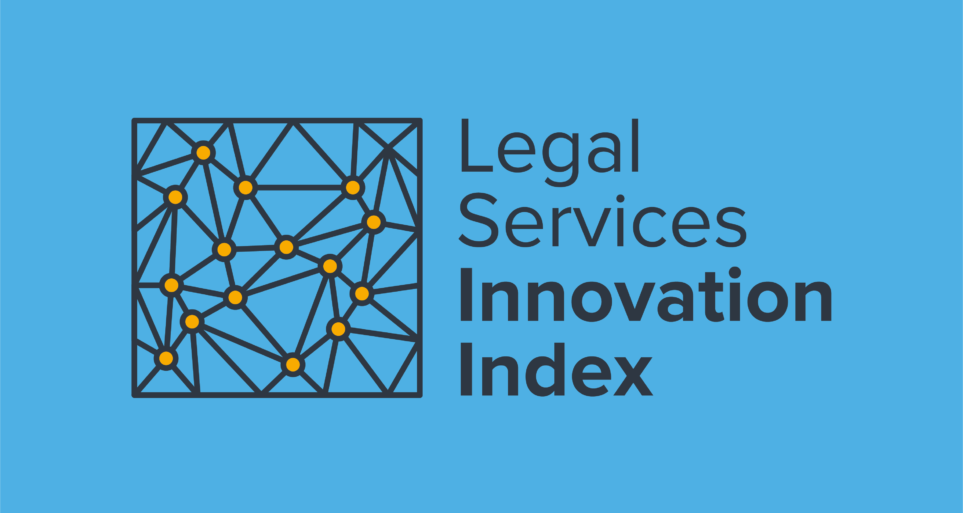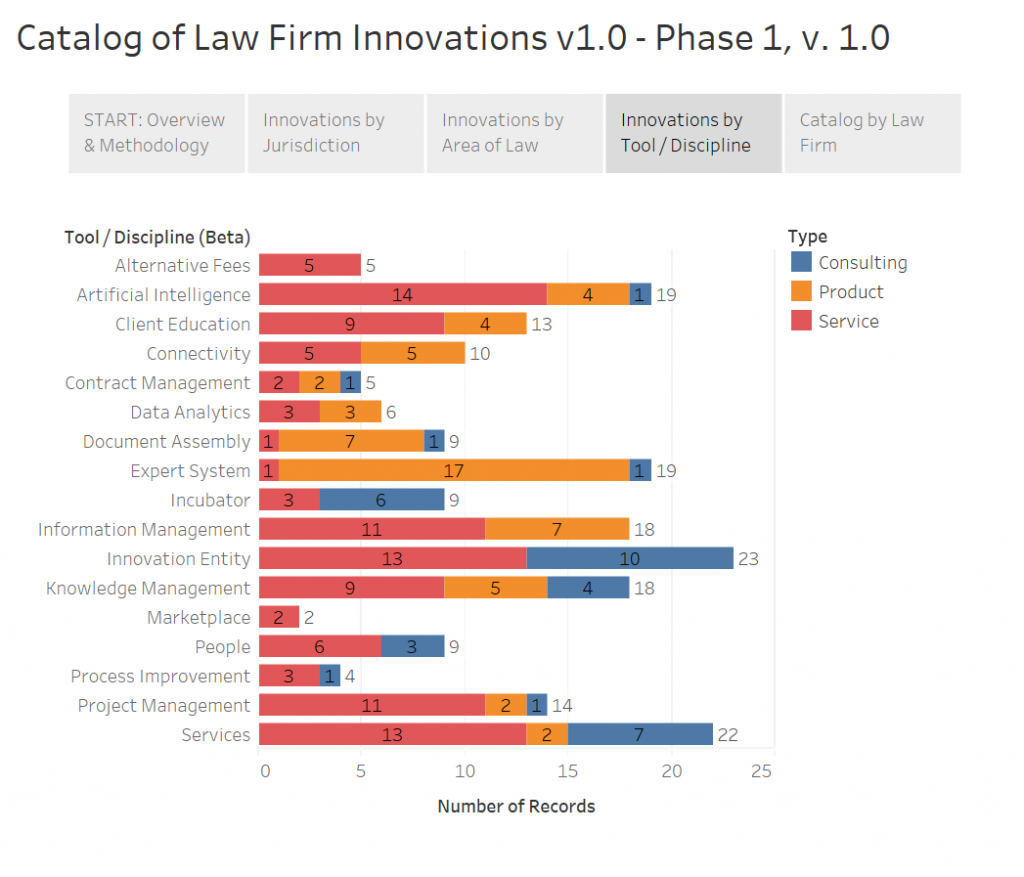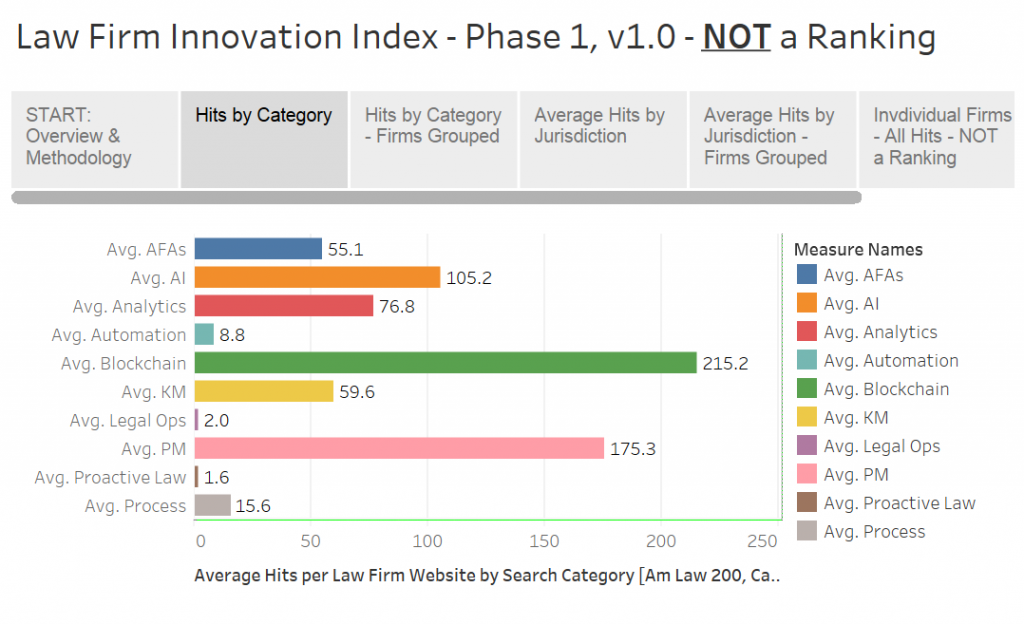In his keynote address to the 2016 CodeX FutureLaw conference, James Sandman, president of the Legal Services Corporation, suggested that one way to accelerate technology adoption in the legal industry would be to assess and rank law firms based on their use of technology. A year later, when Sandman repeated that suggestion at FutureLaw 2017, Daniel W. Linna Jr., director of The Center for Legal Services Innovation at Michigan State University College of Law, realized that no one had taken Sandman up on his suggestion. “Right then,” he later wrote, “I decided to tackle this project.”
Last week, Linna unveiled the fruits of his labor, the Legal Services Innovation Index, a project to create an index of innovation in the delivery of legal services. In what he is calling phase 1, version 1.0, the index consists of two parts, a catalog of law firm innovations and a law firm innovation index. At this point, Linna says, the project is neither a ranking of law firms nor an exhaustive list of innovations, but he hopes that it will eventually become comprehensive.
This index is intended to serve both consumers and producers of legal services. My hope is that clients, including legal departments, will consult this index and engage in deep discussions with their lawyers about how to improve legal-service delivery. Those discussions should include not only how to improve efficiency, but also how to improve quality and obtain better substantive outcomes.
Linna hopes the index will also be a resource for law schools and law students and that, ultimately, it will help improve access to legal services by promoting opportunities for learning, research and collaboration.
The Innovation Catalog
One of the project’s two major components is the catalog of law firm innovations. The purpose of this is to catalog “concrete examples of law firms offering products, legal services, or consulting services that constitute improvements in legal-service delivery or foster legal-service delivery innovations.”
The catalog organizes the innovations that Linna and his research team have identified into four primary categories:
- Innovations by jurisdiction.
- Innovations by areas of law.
- Innovations by tool/discipline and type.
- Innovations by law firm.
That third bullet requires some explanation. The catalog classifies all the innovations by one of three types:
- Product. Something designed to solve a legal problem, such as an expert system.
- Service. Legal services delivered in an innovative way.
- Consulting. Consulting provided to help lawyers innovate and improve legal-service delivery.
The catalog also seeks to identify the tool or discipline driving the innovation. Among these classifications are artificial intelligence, contract management, expert system, and knowledge management. Thus, for each innovation, the catalog identifies both its tool/discipline and whether it is a product, service or consulting.
Putting this all together, the catalog provides some interesting insights into legal industry innovation, including:
- The UK leads the U.S. in numbers of innovations.
- The areas of law where innovations are most common are diligence/transactions, compliance, and e-discovery/litigation.
- Among areas of law where innovation is least common are criminal, international trade, securities litigation, and tax.
- Of the tools and disciplines, the most common areas of innovation are in affiliated law firm entities and services.
Law Firm Innovation Index
The law firm innovation index comes at this from a different angle. It measures law firm innovation based on Google advanced searches of law firm websites for indicators of innovation. Linna admits that this approach has weaknesses, but he says that, given the paucity of information about law firm innovation generally available, determining what law firms claim to be doing about innovation on their own websites is a helpful starting point.
To compile the index, Linna’s team searched the websites of the world’s 260 largest law firms for terms related to 10 categories of innovations:
- Alternative fees.
- Project management.
- Process improvement and innovation framework.
- Knowledge management.
- Automation basics.
- Data analytics.
- Artificial intelligence.
- Legal operations.
- Proactive law.
- Blockchain.
As already noted, there are any number of problems with this approach to evaluating innovation, not the least of which is that a law firm’s website may exaggerate what the firm actually does. Another weakness Linna notes is that this approach disadvantages firms that maintain blogs on separate websites, rather than within the firm’s primary website.
Still, it is, as Linna suggests, an interesting start to indexing law firm innovation. One interesting finding is that the area of innovation that generated the most hits, on average, is blockchain, followed by project management. And, as with the innovation catalog discussed above, UK firms far outpace U.S. firms in indicia of innovation.
Future Plans
Linna says that, moving forward, he plans to periodically update the catalog of innovations with new additions. Beyond that, he hopes to survey clients and to ask law firms to provide information about their innovation efforts and technology usage. Eventually he may expand the index to add innovations in law schools, legal aid organizations, legal startups, legal departments and legal services providers.
Bottom Line
Few efforts have been made to track technological and services innovation at law firms. Until now, probably the most complete efforts has been by Ron Friedmann, who maintains lists of R&D in big law, online legal services, and outsourced legal services. The Legal Services Innovation Index is an important addition to our understanding of what is happening in our industry. Perhaps, as Jim Sandman suggested, it will help to drive greater use of technology and even more innovation.
One obvious shortcoming of this index is that it ignores significant portions of the legal profession. Large firms are neither the only nor the primary sources of technology innovation. Many smaller and mid-sized firms are key drivers of innovation, as are legal services providers, law schools, and private companies. While this index should be commended for filling in part of the picture, let’s also remember that it is only part of the picture.
That said. Linna’s undertaking is already ambitious and his new index is a valuable contribution to our understanding of the state of innovation in law. As Bill Henderson aptly put it at his Legal Evolution blog, “Linna and his students have moved the state of the art from zero to one.”
 Robert Ambrogi Blog
Robert Ambrogi Blog

